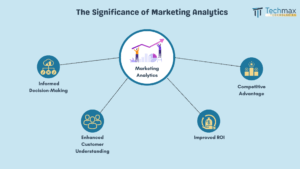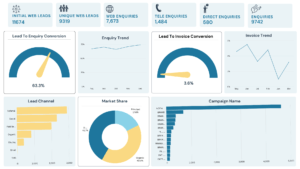Unlock the Future of Marketing: Dive into the World of Marketing Analytics with Techmax Technologies.
Discover the art and science of turning data into powerful marketing insights, and understand why informed decision-making, enhanced customer understanding, improved ROI, and a competitive edge are just a click away. Explore the transformative impact of data-driven marketing tactics, from personalized marketing to real-time optimization. Journey with us as we unveil Techmax Technologies’ Marketing Campaign Dashboard Solutions, your key to unleashing the full potential of marketing analytics.
Harness the power of data, gain a competitive advantage, and elevate your marketing game with Techmax Technologies.
What is Marketing Analytics?
Marketing analytics is the art and science of collecting, analyzing, and interpreting data related to your marketing efforts. It involves tracking various metrics and key performance indicators (KPIs) to gain insights into your campaigns’ effectiveness, customer behavior, and market trends. Essentially, marketing analytics transforms raw data into actionable insights, enabling businesses to make informed decisions and optimize their marketing strategies.
The Significance of Marketing Analytics

1. Informed Decision-Making
In the past, when businesses made marketing decisions, they often relied on their instincts or feelings about what might work. It was like taking a guess. But now, thanks to marketing analytics, things have changed dramatically. Imagine having a treasure trove of facts and figures that show you exactly what works and what doesn’t in your marketing efforts. This is what marketing analytics provides – solid data that shines a bright light on the effectiveness of your strategies. It’s like having a reliable map that guides you to allocate your resources wisely and make smart decisions about your marketing campaigns. In essence, it replaces guesswork with a clear path based on real information.
2. Enhanced Customer Understanding
Marketing analytics goes beyond just looking at numbers; it’s like getting to know your customers well. Imagine you have a special tool that lets you peek into how your customers act and what they like. You can find out things like what they prefer, where they come from, and how they like to shop. Armed with this info, you can create marketing messages that feel like they’re made just for each customer. It’s like having a direct phone line to what your customers want and need. This helps make their experience with your business much better.
3. Improved ROI
Think of your marketing budget as a stash of money you use to promote your business. Every dollar in that stash is precious. Marketing analytics is like having a super precise calculator that helps you see exactly where each of those dollars goes and what it brings back. It tracks how well different ways of promoting your business are working. So, if some methods are doing a great job and bringing in more money than you spent, you know to keep doing them. But if others are just eating up your money without giving much back, you can stop or change them. It’s like having a GPS for your budget that keeps you on the path to getting the most out of every dollar you spend.
4. Competitive Advantage
In the fast and busy world of business today, being ahead of your competition is important. Marketing analytics is like having a special tool that helps you see things happening in the market before others do. It’s like having a radar that spots trends and new chances in your industry early on. When you can see these things quickly, you can make changes to your business strategy faster than your competitors. This means you can stay in front and keep your edge in the industry. It’s like being a step ahead in a race, and marketing analytics is your secret weapon to help you do that.
The Impact of Data-Driven Marketing Tactics
Data-driven marketing tactics represent the bedrock upon which contemporary marketing success is built. In an era where information is currency, these tactics wield the power to revolutionize your business strategies and outcomes. By harnessing the insights gleaned from data, you can unlock a realm of once inconceivable possibilities. In this data-driven landscape, your marketing efforts become finely tuned instruments, capable of delivering precise and impactful results. Let’s delve into how these tactics have the potential to reshape your business and drive it toward unprecedented success:
1. Personalized Marketing
Data-driven marketing tactics empower businesses to create marketing campaigns that are highly personalized to individual customer preferences. By analyzing customer data, such as past purchase history, browsing behavior, and demographic information, you can tailor your messages and offers to resonate with each customer on a personal level. This personalization not only enhances customer engagement but also leads to higher conversion rates. It’s like having a one-on-one conversation with your customers, offering them exactly what they want.
2. Targeted Advertising
Data-driven insights allow you to identify your ideal customer segments with precision. Instead of casting a wide net with your advertising efforts, you can hone in on the specific groups of people most likely to be interested in your products or services. This not only minimizes ad spend wastage but also maximizes your chances of reaching potential customers who are genuinely interested in what you offer. It’s like sending your message directly to the people who are most likely to respond positively.
3. Improved Customer Retention
Analyzing customer behavior and feedback through data-driven approaches helps identify pain points and areas for improvement in your products or services. By addressing these issues promptly, you can enhance the customer experience, which, in turn, leads to better customer retention and loyalty. It’s like continuously fine-tuning your offerings to meet and exceed your customers’ expectations, ensuring they keep coming back.
4. Real-Time Optimization
Data-driven marketing provides the ability to monitor campaign performance in real-time. This means that if something in your marketing strategy isn’t working as expected, you can make immediate adjustments. Whether it’s reallocating resources to high-performing channels or tweaking messaging for better resonance, real-time optimization allows you to fine-tune your marketing efforts on the fly. It’s akin to steering a ship while constantly adjusting the course based on real-time navigation data, ensuring you reach your destination efficiently and effectively.
Leveraging Techmax Technologies’ Marketing Campaign Dashboard Solutions

Techmax Technologies’ Marketing Campaign Dashboard is a game-changer in the realm of marketing analytics. This powerful tool integrates critical KPIs, provides a centralized data hub for a 360-degree campaign view, and enables real-time monitoring, fostering data-driven decision-making.
With seamless tracking of online efforts, including web leads and enquiries, it offers a holistic perspective on lead generation. Conversion rates are addressed comprehensively, allowing clients to optimize their strategies.
Additionally, campaign-specific metrics empower clients to identify top-performing channels and allocate resources effectively. The dashboard’s insights into trends in enquiries and invoices enable businesses to stay ahead and adapt to changing market dynamics.
In conclusion, Techmax Technologies’ Marketing Campaign Dashboard Solutions unlock the future of marketing by harnessing data-driven insights for personalized marketing, targeted advertising, and enhanced customer retention. Real-time optimization and a 360-degree view empower businesses to reach new levels of precision and effectiveness. This dashboard is the key to unleashing the full potential of marketing analytics in today’s data-driven era, propelling businesses toward unparalleled success.





